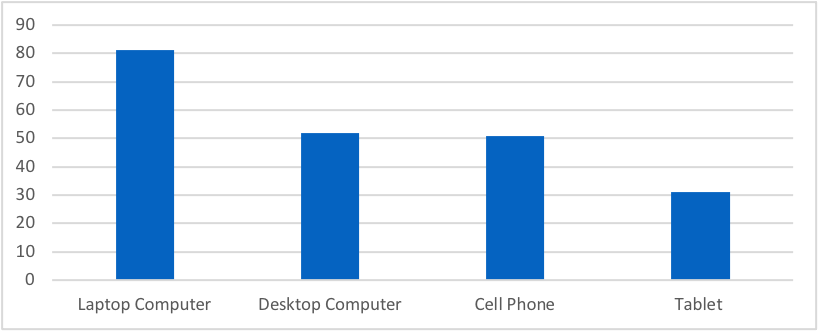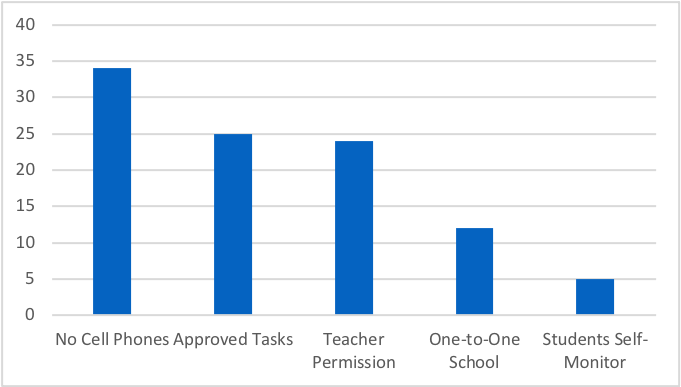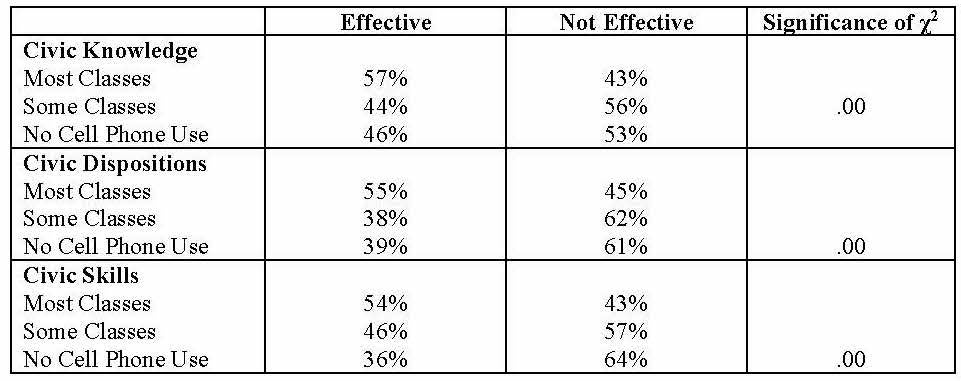Cell Phones as Instructional Technology in the Civics Classroom: Key Findings

The use of digital technology has become increasingly prevalent in American elementary and secondary school civics classrooms. A 2019 Gallup study found that 65% of teachers use digital technology in the classroom daily, with history and social studies instructors among the most frequent users. Many students own cell phones, and cell phone technology has advanced to the point of allowing students to use them for their studies. Cell phones have the potential to enhance civics instruction in myriad ways, and can bridge the technology gap that exists between high-needs students and their counterparts at well-resourced schools. However, cell phones can distract students, constrain their development of crucial research skills, and hamper face-to-face classroom interactions. These conflicting factors have resulted in wide variations in cell phone policies across and within schools, with some institutions and teachers fully embracing their instructional capacities and others banning their use.
Dr. Diana Owen and Chelsea Sanchez of CERL presented a paper exploring the use of cell phones by civic educators at the elementary, middle, and high school levels at the American Political Science Association Annual Meeting on September 11, 2020. This study employs data from an original survey of elementary, middle, and high school teachers that was conducted by Dr. Diana Owen and graduate students in Georgetown University’s Communication, Culture, and Technology (CCT) program. It was administered online to civics, social studies, and American government teachers recruited from the networks of the Center for Civic Education and the Bill of Rights Institute. The study was in the field from November 15 to December 6, 2019, prior to the COVID-19 pandemic. A total of 1,146 teachers who completed the survey were included in the analysis, consisting of 825 high school teachers, 271 middle school teachers, and 48 elementary school teachers.
Teacher Support of Digital Tools in the Classroom
Our study reinforced trends identified by Gallup showing that 96% of teachers support the use of digital tools in the classroom. Almost all the civics teachers (98%) responding to our survey used digital learning tools, defined as any learning aids used by educators and students that employ digital technology in the civics classroom. Laptop computers (81%) were overwhelmingly the most common device used to support the use of digital tools for instruction. Tablets (31%) were used in the smallest percentage of classrooms. Desktop computers (52%) and cell phones were employed at nearly the same rate. 51% of teachers in our study reported that their students used cell phones for learning in their classrooms. (See Figure 1.) Of teachers who used cell phones for civics instruction, 5% did so in every class, 18% in most classes, and 77% in some classes.
Figure 1
Devices Used in the Civics Classroom

Civics Teachers and Cell Phone Policies
In our study, teachers responded to an open-ended question that asked about their policy for in-class cell phone use. One-third of teachers reported that their school had a no cell phone policy. (See Figure 2.) At the other end of the spectrum, only 5% of schools had no limits on cell phone use or allowed students to self-monitor. One-quarter of teachers indicated that students could use cell phones for approved tasks. Another quarter of the respondents allowed cell phones to be used with the permission of the instructor. 12% of teachers specifically mentioned that their school supplied students with devices, such as Chromebooks, that they could use in the classroom which would curtail the use of cell phones.
Figure 2
Cell Phone Policies

Key Findings: Cell Phone Policy by School Characteristics
- Approximately half of both middle and elementary school teachers outright banned cell phones in the classroom.
- High school teachers had more varied policies: nearly a third (29%) banned cell phones, 26% permitted their use for approved tasks, and 26% allowed them with teacher permission.
- Technical schools permitted cell phones more often than other types of schools. Only 17% of teachers in technical schools banned cell phones in the classroom.
- Teachers in Title I schools (38%) were somewhat more likely to ban cell phone use in the classroom than teachers in non-Title I schools (29%)
- One third of teachers at both one-to-one schools (34%) and non-one-to-one schools (33%) banned cell phones in the classroom
- The percentage of teachers who ban cell phones in the classroom decreases as school size increases.
Table 1
Cell Phone Policy by School Characteristics

All relationships have a χ statistical significance of p≤.01 except public/private school which is non-significant.
Key Findings: Cell Phone Access in the Civics Classroom
- Cell phone access is a prerequisite for their use in the classroom
- 67% of high school, 35% of middle school, and 48% of elementary school teachers reported that all students had access to cell phones.
- Universal access was higher in private schools (81%) than public schools (56%)
- Students in Title I schools (51%) had less access to cell phones than students in non-Title I schools (67%)
- Teachers in one-to one schools (63%) were more likely to report that all students had cell phones than those in schools where students were not all assigned a device (54%).
- Technical schools, religious schools, and magnet schools had greater cell phone access than other types of schools
- 72% of teachers in large schools reported that their students all had access compared to 56% in small schools
Table 2
Student Access to Cell Phones by School Characteristics

Key Findings: Teaching Civics Using Cell Phones
- High school teachers were more likely to use cell phones for instruction than middle or elementary school teachers
- Cell phones in civics class were more prevalent in public schools (52%) than private schools (42%)
- Teachers in religious and charter schools were the least likely to teach with cell phones
- More than half of teachers in alternative, magnet, and technical schools used cell phones in the classroom
- Title I school teachers (47%) were less likely to instruct with cell phones than non-Title I school teachers (55%)
- Teachers in one-to-one schools (45%) were less likely to use cell phones than those in schools that were not one-to-one (58%)
- Larger school size and class size were positively related to cell phone use
Table 3
Classroom Cell Phone Use by School Characteristics

Key Findings: Cell Phone Use by Teacher Characteristics
- There were no statistically meaningful differences in teachers’ age, gender, education, or years teaching civics related to their use of cell phones in the classroom
- Teachers of adult education, ELL/ESL students, pre-service teachers, and teachers of Native American students were more likely to use cell phones
- Teachers of AP classes (60%) and honors classes (54%) instructed with cell phones more than those who did not teach AP or honors (46%)
Table 4
Classroom Cell Phone Use by Teacher Characteristics

Key Findings: How Cell Phones are Used in the Civics Classroom
- 90% of students used cell phones to look up information
- 70% of students conducted research for class using cell phones
- Half of students used cell phones to communicate with teachers and classmates
Table 5
How Students Use Cell Phones for Learning
(% of those who use cell phones for learning in the classroom)

Key Findings: Effectiveness in Achieving Civics Outcomes
- Even teachers who use cell phones frequently for instruction were not convinced about their effectiveness in imparting civic knowledge, skills, and dispositions
- Over half of teachers who used cell phones for learning in most classes perceived that the devices were effective in promoting civic knowledge (57%), dispositions (55%), and skills (54%)
- 44% of teachers who used cell phones sometimes or never felt they were effective in conveying civic knowledge
- 38% of teachers who used them sometimes or never believed they were effective for imparting civic dispositions
- 46% of teachers who sometimes taught with cell phones and 36% of those who never used them felt cell phone use was effective for conveying civic skills
Table 6
Teachers’ Perceptions on the Effectiveness of Cell Phone Use on Civic Outcomes

